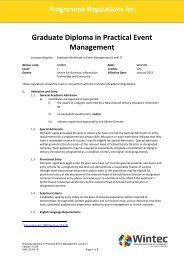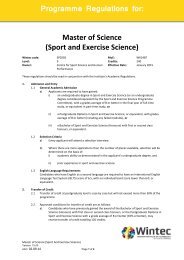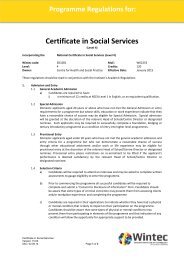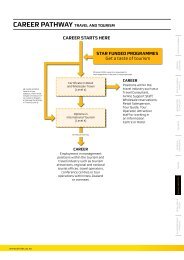Physiological analysis of the metabolic typing diet in professional ...
Physiological analysis of the metabolic typing diet in professional ...
Physiological analysis of the metabolic typing diet in professional ...
Create successful ePaper yourself
Turn your PDF publications into a flip-book with our unique Google optimized e-Paper software.
and sport-specific nutrition guidel<strong>in</strong>es are required<br />
based on evidence specifically based on rugby union<br />
and not on laboratory based endurance sports.<br />
Large improvements <strong>in</strong> strength, size, speed, and<br />
fitness <strong>of</strong> <strong>the</strong> pr<strong>of</strong>essional rugby player have been<br />
achieved and as a direct result <strong>of</strong> <strong>the</strong> <strong>in</strong>creased<br />
demand on players, <strong>the</strong>re has been a need to<br />
improve nutrition and <strong>diet</strong> around tra<strong>in</strong><strong>in</strong>g and<br />
competition 3,4 . Despite <strong>the</strong> improvement <strong>of</strong> many<br />
rugby union nutrition programmes driven from<br />
nutritionists, <strong>diet</strong>itians and fitness tra<strong>in</strong>ers, <strong>the</strong>re are<br />
still many pr<strong>of</strong>essional players fail<strong>in</strong>g to fully achieve<br />
<strong>the</strong>ir true potential due to poor nutrition. In some<br />
prov<strong>in</strong>ces and franchise areas with<strong>in</strong> New Zealand,<br />
well-monitored nutrition programmes have been<br />
implemented and driven from academy-level to<br />
All Black level. However, many programmes are<br />
generic due to <strong>the</strong> large number <strong>of</strong> players <strong>the</strong>y<br />
must <strong>in</strong>clude. Unpublished reports from rugby<br />
tra<strong>in</strong>ers have shown that some players adher<strong>in</strong>g to<br />
traditional ‘good nutrition’ guidel<strong>in</strong>es still struggle<br />
to achieve required standards <strong>of</strong> <strong>in</strong>creas<strong>in</strong>g lean<br />
muscle mass and reduc<strong>in</strong>g fat.<br />
<strong>of</strong> feel<strong>in</strong>g satisfied. If, with<strong>in</strong> 1-2 hours after eat<strong>in</strong>g,<br />
you feel more tired, or your mood worsens, or you<br />
still feel hungry, crave sweets or feel like you need a<br />
“pick-me-up,” <strong>the</strong>n you need to change <strong>the</strong> ratio <strong>of</strong><br />
prote<strong>in</strong>s, fats and carbohydrates at that meal until<br />
your symptoms improve.” 7 .<br />
Wolcott & Fahey 7<br />
state <strong>the</strong> MDT is based on <strong>the</strong><br />
factual <strong>in</strong>formation derived from thousands <strong>of</strong> years<br />
<strong>of</strong> evolutionary history, as people <strong>in</strong> different parts<br />
<strong>of</strong> <strong>the</strong> world developed very dist<strong>in</strong>ct nutritional<br />
needs - referred to as ‘biochemical <strong>in</strong>dividuality’ -<br />
<strong>in</strong> response to a wide range <strong>of</strong> variables, <strong>in</strong>clud<strong>in</strong>g<br />
climate, geography, and <strong>the</strong> plant and animal life<br />
<strong>the</strong>ir environments supplied. They suggest that as a<br />
result <strong>of</strong> biochemical <strong>in</strong>dividuality, people now have<br />
extensively vary<strong>in</strong>g nutrient requirements, especially<br />
with regard to <strong>the</strong> macronutrients. Alternative health<br />
care practitioners advocate that <strong>in</strong>dividuals have<br />
genetically programmed requirements for different<br />
amounts <strong>of</strong> various nutrients, which is believed to<br />
expla<strong>in</strong> why a nutrient can cause one person to feel<br />
good, have no effect on ano<strong>the</strong>r, and cause a third<br />
person to feel worse.<br />
Nutrition, as with strength, speed or power<br />
tra<strong>in</strong><strong>in</strong>g, needs to be specific and customised to<br />
meet needs <strong>of</strong> <strong>the</strong> <strong>in</strong>dividual athlete. If <strong>in</strong>dividual<br />
nutritional requirements can be fully understood<br />
and implemented <strong>in</strong>to everyday tra<strong>in</strong><strong>in</strong>g and<br />
compet<strong>in</strong>g, an athlete should be well-placed<br />
to advance and progress toward achiev<strong>in</strong>g true<br />
athletic potential 5,6 . Therefore, this study exam<strong>in</strong>ed<br />
<strong>the</strong> possible beneficial effects <strong>the</strong> Metabolic Typ<strong>in</strong>g<br />
Diet (MTD) may <strong>of</strong>fer due to its <strong>in</strong>dividual based<br />
requirements.<br />
The authors <strong>of</strong> <strong>the</strong> MTD suggest <strong>the</strong>y can uncover<br />
patterns <strong>of</strong> <strong>the</strong> genetically-based strengths and<br />
weaknesses that make each athlete unique on a<br />
physiological and biochemical level 7 . The concept <strong>of</strong><br />
<strong>the</strong> <strong>diet</strong> has “…evolved through a correlation <strong>of</strong> <strong>the</strong><br />
known scientific facts concern<strong>in</strong>g <strong>the</strong> fundamental<br />
control systems, with <strong>the</strong> cl<strong>in</strong>ical observation and<br />
empirical experience <strong>of</strong> hundreds <strong>of</strong> practitioners,<br />
with over 60,000 cases over <strong>the</strong> last 25 years.” 8,9 .<br />
Nutrition can be an area <strong>of</strong> confusion amongst<br />
athletes with changes <strong>in</strong> knowledge or <strong>in</strong>terpretation<br />
<strong>of</strong> <strong>the</strong> knowledge occurr<strong>in</strong>g all <strong>the</strong> time. It is fur<strong>the</strong>r<br />
confused by <strong>the</strong> fact that <strong>in</strong>dividuals respond <strong>in</strong><br />
differ<strong>in</strong>g ways to nutritional regimes. The idea that<br />
people differ based on <strong>the</strong>ir metabolism is <strong>the</strong> basis<br />
<strong>of</strong> <strong>the</strong> MTD, <strong>of</strong> which <strong>the</strong> authors claim “…one man’s<br />
food is ano<strong>the</strong>r’s poison.”<br />
The MDT attempts to <strong>in</strong>dividualise recommendations<br />
to athletes (and sedentary people as well) by<br />
estimat<strong>in</strong>g <strong>metabolic</strong> processes by way <strong>of</strong> a<br />
questionnaire. The suggested <strong>diet</strong>s differ <strong>in</strong><br />
macronutrients consumed that allow “…maximum<br />
energy, peak performance, normalise appetite and<br />
be as trim as you can be.” 7 . Accord<strong>in</strong>g to <strong>the</strong> <strong>diet</strong>,<br />
after eat<strong>in</strong>g you should feel an “…elevation <strong>of</strong> your<br />
energy, a normalization <strong>of</strong> your moods, and a sense<br />
Wolcott & Fahey 7<br />
propose that <strong>the</strong>re are three<br />
general <strong>metabolic</strong> types:<br />
• Prote<strong>in</strong> types - are ‘fast oxidisers’ who tend to<br />
be frequently hungry, crave fatty, salty foods,<br />
fail with low-calorie <strong>diet</strong>s, and tend towards<br />
fatigue, anxiety, and nervousness. They are <strong>of</strong>ten<br />
lethargic or feel ‘wired’, ‘on edge’, with superficial<br />
energy while be<strong>in</strong>g tired underneath.<br />
• Carbohydrate types - are ‘slow oxidisers’ who<br />
generally have relatively weak appetites, a high<br />
tolerance for sweets, problems with weight<br />
management, “type A” personalities, and are<br />
<strong>of</strong>ten dependent on caffe<strong>in</strong>e.<br />
• Mixed types - are ‘mixed oxidisers’ who generally<br />
have average appetites, crav<strong>in</strong>gs for sweets and<br />
starchy foods, relatively little trouble with weight<br />
control, and tend towards fatigue, anxiety, and<br />
nervousness.<br />
Accord<strong>in</strong>g to <strong>the</strong> <strong>metabolic</strong> <strong>typ<strong>in</strong>g</strong> <strong>diet</strong>, <strong>the</strong> three<br />
<strong>metabolic</strong> types should eat <strong>the</strong> follow<strong>in</strong>g foods:<br />
• Prote<strong>in</strong> types should eat <strong>diet</strong>s that are rich <strong>in</strong><br />
prote<strong>in</strong>, fats and oils, and high-pur<strong>in</strong>e prote<strong>in</strong>s<br />
such as organ meats, pate, beef liver, chicken<br />
liver, and beef. Carbohydrate <strong>in</strong>take should be<br />
low.<br />
• Carbohydrate types should eat <strong>diet</strong>s that are high<br />
<strong>in</strong> carbohydrates and low <strong>in</strong> prote<strong>in</strong>, fats, and<br />
oils. They should eat light, low-pur<strong>in</strong>e prote<strong>in</strong>s.<br />
• Mixed types should eat a mixture <strong>of</strong> high-fat,<br />
high-pur<strong>in</strong>e prote<strong>in</strong>s and low-fat, low-pur<strong>in</strong>e<br />
prote<strong>in</strong>s such as cheese, eggs, yogurt, t<strong>of</strong>u,<br />
nuts. This type requires relatively equal ratios <strong>of</strong><br />
prote<strong>in</strong>s, fats, and carbohydrates.<br />
For each <strong>metabolic</strong> type an <strong>in</strong>dividual is<br />
recommended to consume a <strong>diet</strong> relative to<br />
<strong>the</strong>ir <strong>metabolic</strong> type which is considered to be<br />
appropriate and essential to provid<strong>in</strong>g <strong>the</strong>m with<br />
Vol 35, No. 2<br />
43

















